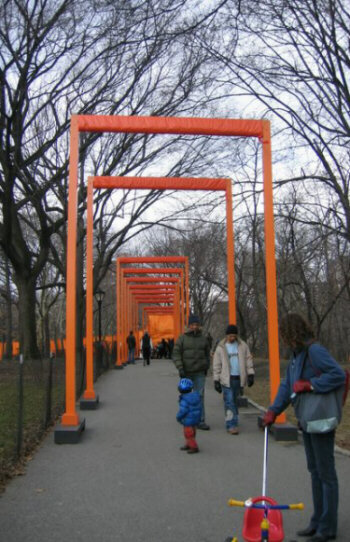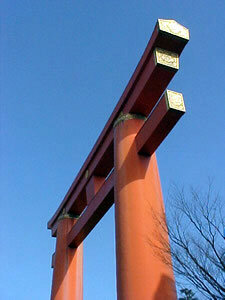 Sha’arei Tzedek
Sha’arei Tzedek
The Russian Formalist art critic Viktor Shklovsky is usually credited with coining the concept of defamiliarization to articulate the crucial essence of art. To take a piece of the world and to use art to defamiliarize it – to make it new – that is what art is for. According to Shklovsky, or to the criterion of spectacle by which so much modern activity is judged, Christo’s just-ended project in Central Park (“The Gates: Central Park, New York 1979-2005”) is the most significant artwork in the world at the moment. It is clear, even to someone as previously skeptical about the project as myself, that The Gates have radically refigured the park in an extremely tangible way.
Usually, February in Central Park reflects the Seasonal Affective Disorder that afflicts the whole East Coast. Christianity marks this period of the year with its Lenten countdown to Easter; checking off the days to rebirth normally seems to make perfect sense for everyone during this cold, dark month. Suddenly, though, there is a positive reason to come together and visit the most famous public space in the world. Two bright weekends and a snowy Presidents’ Day have dawned on a park packed with visitors and locals all gathered to be in a piece of art, a piece of community.
Though many other critics have observed insightfully how The Gates shifts perception of space and movement, or how it extends beyond its physical manifestation across the twenty-six years of its conception, it is this sense of community that marks out The Gates from any other exhibition or installation I have ever seen. As of this writing, barely halfway through its life in the park, over a million people have already used the orange portals to enter into a joint experience defined physically by the 7500 gates and in time by the strict limits of its display (from Feb 12th to Feb 28th). “Have you seen The Gates?” is the invitation to join the community and, with 40 miles to choose from and no entry fee, the invitation is often accepted. In the normal course of events there is a theoretical community of people gazing at an artwork, whether it is hanging on the wall of a museum or standing in the middle of a plaza, but here the exhibition itself marks and encloses the community in a warm orange glow.
 It is not an exclusive community – the beauty of choosing gates and putting them in the middle of a space is that they open both ways. The gates themselves resemble the beautiful, auspicious torii that stand over the entrances of Japanese temples but they don’t signify a direction of increasing sanctity. The gates are far more democratic than any organized religion, though: they vary in size and shape depending on their location, but none is more important than other, none taking precedence. (Christo's creative and life partner, Jeanne-Claude, has insisted that there is no one 'best place' to view The Gates).
It is not an exclusive community – the beauty of choosing gates and putting them in the middle of a space is that they open both ways. The gates themselves resemble the beautiful, auspicious torii that stand over the entrances of Japanese temples but they don’t signify a direction of increasing sanctity. The gates are far more democratic than any organized religion, though: they vary in size and shape depending on their location, but none is more important than other, none taking precedence. (Christo's creative and life partner, Jeanne-Claude, has insisted that there is no one 'best place' to view The Gates).
Not only are the visitors continually entering a space that is sanctified by walking through the gateways but they are also within the space defined on either side by the gates that line the paths on the outside of the park. So too, it isn't just the inside of the park that is part of the orange experience -- but also the windows, buntings, and even the hoardings surrounding the park echo the dawn-coloured monuments. From anywhere within sight of the installation strangers are wearing orange, talking to one another, snapping photos, relating to the art. Surely it is a coincidence that the saffron-orange in the park is the same as the orange of the democratic movement in Ukraine, but the coincidence works. This is a true demonstration of mass democracy: not in the party-political sense but in the sense the people are in charge, are using the public structures for their own communal ends.



Shakey: An Essay on Anger
Jay Michaelson
Giving Thanks to Elijah the Prophet in Indian Manhattan
Jonathan Schorsch
Three Nights
Jill Hammer
The Pursuit of Justice
Emily Rosenberg
Sha'arei Tzedek
Dan Friedman
God's Unchanging Hand
Daniel Cohen
Archive
Our 610 Back Pages
Neurotic Visionaries & Paranoid Jews
April 7, 2005
Zeek in Print
Fall/Winter 2004 issue now on sale
About Zeek
Mailing List
Contact Us
Subscribe
Tech Support
Links
From previous issues:
Hasidism and Homoeroticism
Jay Michaelson
Sitting on an aeroplane, while Grandma Dies
Nigel Savage
I'll Say Goodbye and Let You Go
Abigail Pickus
